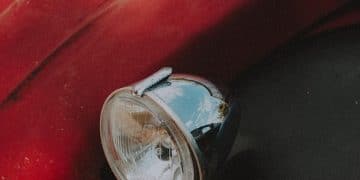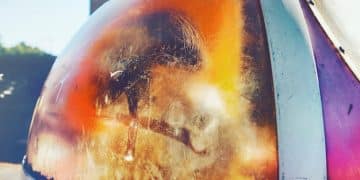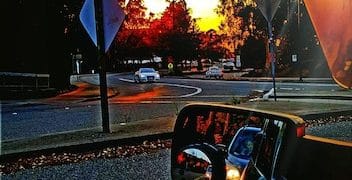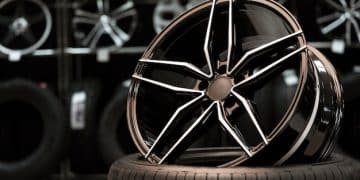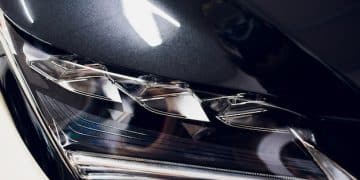Headlight Restoration: Your Guide to Like-New Headlights
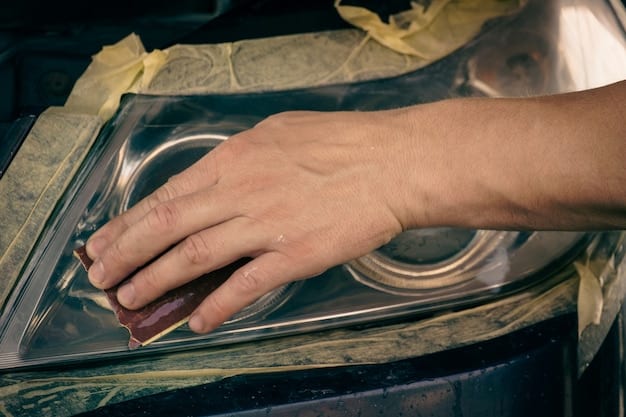
Headlight restoration is the process of removing the cloudy or yellowed layer from your headlights, improving visibility and enhancing your car’s appearance, often achievable through DIY methods or professional services to bring them back to like-new condition.
Cloudy headlights not only diminish your car’s aesthetic appeal but also significantly reduce visibility, especially during nighttime driving. Headlight restoration is a cost-effective solution to bring back that like-new clarity, enhancing safety, and saving you from expensive replacements.
Understanding Headlight Clouding
Headlight clouding, often referred to as oxidation, is a common issue affecting most vehicles. This cloudiness isn’t just a cosmetic problem; it directly impacts your safety on the road.
The primary culprit behind cloudy headlights is the degradation of the plastic lens material due to prolonged exposure to ultraviolet (UV) rays from the sun. Let’s delve deeper into the causes and why it’s essential to address this issue.
Causes of Headlight Clouding
Several factors contribute to the development of cloudy headlights:
- UV Exposure: Sunlight is a significant factor that causes the plastic lens covers to break down over time.
- Environmental Factors: Exposure to road salts, grime, and pollutants can accelerate the clouding process.
- Weather Conditions: Extreme weather conditions, such as heat and cold, can stress the plastic, leading to cracking and discoloration.
- Chemical Exposure: Chemicals from car washes or detergents can damage the lens surface.
Safety Implications of Cloudy Headlights
Cloudy headlights can severely compromise your visibility, especially at night or during bad weather.
This reduced visibility can significantly increase the risk of accidents, as it reduces your reaction time and ability to see potential hazards. Restoring your headlights is a critical step in ensuring your safety and the safety of others on the road.
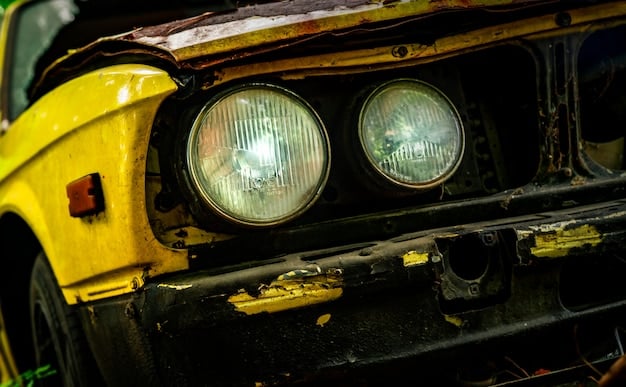
In conclusion, understanding the causes and implications of headlight clouding is crucial for maintaining vehicle safety and appearance. Regular maintenance and timely restoration can make a significant difference.
DIY Headlight Restoration Methods
Restoring your headlights doesn’t always require professional help. Several DIY methods can effectively remove the cloudiness and restore clarity.
These methods range from using household items to purchasing specialized restoration kits. Each approach varies in effectiveness and required effort.
Household Cleaning Methods
You might be surprised to learn that some common household items can be used to restore headlights.
- Baking Soda and Vinegar: Create a paste and apply it to the headlights, then rinse. This can help remove light oxidation.
- Toothpaste: Non-gel toothpaste can act as a mild abrasive, polishing away minor imperfections.
- WD-40: Spray WD-40 onto the headlights and wipe clean. This can temporarily improve clarity.
Headlight Restoration Kits
For a more professional-grade result, consider using a headlight restoration kit.
These kits typically include everything you need to restore your headlights, such as sanding pads, polishing compounds, and UV sealant.
Step-by-Step Guide to Using Restoration Kits
Here’s a general guide on how to use a headlight restoration kit:
- Clean the headlight surface with soap and water.
- Tape off the surrounding paint to protect it.
- Sand the headlight with the provided sandpaper, starting with the coarsest grit and moving to finer grits.
- Apply the polishing compound using a polishing pad or cloth.
- Wipe off the compound and apply the UV sealant to protect the lens.
DIY headlight restoration methods can be effective, especially for mild cloudiness. Just be sure to follow instructions carefully and use appropriate materials to avoid damaging the headlights.
Professional Headlight Restoration Services
When DIY methods aren’t cutting it, or if you prefer a guaranteed result, professional headlight restoration services are the way to go.
These services offer specialized tools and expertise to restore headlights to their optimal condition. Let’s explore what these services entail and why you might choose them.
What to Expect from Professional Services
Professional headlight restoration typically involves a more comprehensive approach than DIY methods.
- Thorough Cleaning: Professionals will start with a deep cleaning of the headlight surface to remove dirt and grime.
- Advanced Sanding and Polishing: They use professional-grade sanding and polishing tools for more effective restoration.
- UV Coating Application: A high-quality UV coating is applied to protect the headlights from future oxidation.
- Warranty: Many professional services offer a warranty on their work, providing peace of mind.
Benefits of Choosing Professional Restoration
Opting for professional headlight restoration services comes with several advantages.
Professionals have the expertise and tools to achieve superior results, often restoring headlights to near-new condition. They also save you time and effort, with the job typically completed in under an hour. Additionally, a professional service often includes a warranty, giving you added confidence in the quality of the work.
Cost Considerations
The cost of professional headlight restoration can vary depending on the service provider and the condition of your headlights.
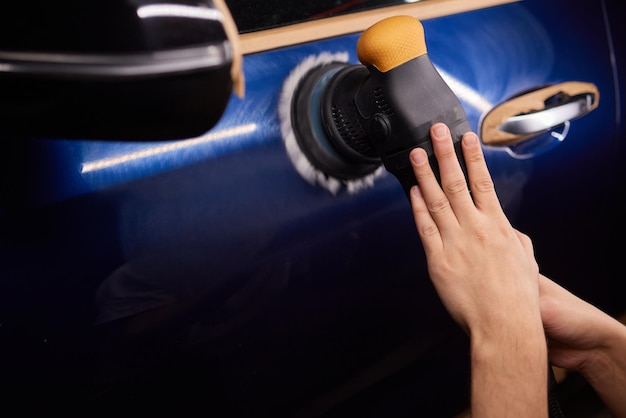
While the upfront cost might be higher than DIY kits, the long-term benefits and quality of the result often justify the expense. In the end, entrusting your headlight restoration to professionals ensures high-quality results and long-lasting protection.
Choosing the Right Method for Your Needs
Deciding between DIY and professional headlight restoration depends on your budget, skill level, and the condition of your headlights.
Each approach has its own set of advantages and disadvantages. Let’s break down the factors to consider when making your choice.
Assessing the Condition of Your Headlights
Before choosing a restoration method, carefully assess the level of cloudiness and damage on your headlights.
If the cloudiness is mild, DIY methods like baking soda and vinegar or a basic restoration kit might suffice. However, if the headlights are heavily oxidized, cracked, or severely yellowed, professional services are likely needed.
Evaluating Your Skill Level and Time Commitment
Consider your comfort level with DIY projects and the amount of time you’re willing to invest.
DIY headlight restoration can be time-consuming and requires attention to detail. If you’re not confident in your ability to follow instructions and handle tools, it’s best to opt for professional help to avoid potential damage.
Cost vs. Benefit Analysis
Weigh the cost of each method against the expected results and longevity.
- DIY Kits: Affordable and convenient, but results may vary and may not last as long.
- Household Methods: Very inexpensive, but generally less effective and only suitable for minor cloudiness.
- Professional Services: More expensive, but offer superior results, longer-lasting protection, and often come with a warranty.
Ultimately, the best method depends on your priorities and circumstances. Take the time to assess your needs and make an informed decision.
Maintaining Your Restored Headlights
Once you’ve restored your headlights, it’s essential to maintain their clarity to prevent future clouding.
Regular maintenance can significantly extend the life of your restored headlights and ensure optimal visibility on the road. Here are practical tips to keep your headlights looking like new.
Regular Cleaning
Clean your headlights regularly to remove dirt, grime, and pollutants.
Use a mild soap and water solution, and avoid harsh chemicals or abrasive cleaners that could damage the lens surface. A soft cloth or sponge is ideal for cleaning without scratching the plastic.
Applying UV Protectant Sprays or Sealants
UV protectant sprays or sealants provide a barrier against harmful UV rays.
Applying these products periodically can prevent the plastic from yellowing and clouding over time. Reapply the UV protectant every few months for best results.
Parking in Shaded Areas
Whenever possible, park your car in shaded areas or garages to minimize exposure to sunlight.
Reducing the amount of direct sunlight your headlights receive can slow down the oxidation process and keep them clear for longer. This simple habit can significantly prolong the life of your restored headlights.
Remember, regular maintenance is key to preserving the clarity of your restored headlights and ensuring your safety on the road.
| Key Point | Brief Description |
|---|---|
| ☀️ UV Exposure | Main cause of clouding; sunlight degrades plastic over time. |
| 🧽 DIY Cleaning | Use household items like baking soda or toothpaste. |
| 🛠️ Restoration Kits | Include sanding pads, polishing compounds, and UV sealant. |
| 🛡️ Professional Services | Offers warranties and UV coating application. |
FAQ
▼
Headlights turn cloudy primarily due to oxidation from UV exposure, environmental pollutants, and weather-related factors, which degrade the plastic lens over time.
▼
Yes, headlight restoration is worth it. It improves visibility, enhances safety, and saves money compared to headlight replacement, while also improving the car’s appearance.
▼
Headlight restoration can last from six months to two years, depending on the restoration method used and how well the headlights are maintained afterward with UV protectants.
▼
Yes, non-gel toothpaste can be used as a mild abrasive to polish and clean headlights, which helps remove minor cloudiness and improve clarity temporarily.
▼
The best way to protect restored headlights is by applying UV protectant sprays or sealants regularly and parking in shaded areas to minimize exposure to sunlight.
Conclusion
In summary, restoring your headlights is a worthwhile investment in your safety and your vehicle’s appearance. Whether you choose a DIY method or opt for professional services, the key is to address headlight clouding promptly and maintain their clarity through regular upkeep. Clear headlights ensure better visibility, safer driving, and a more attractive car.
